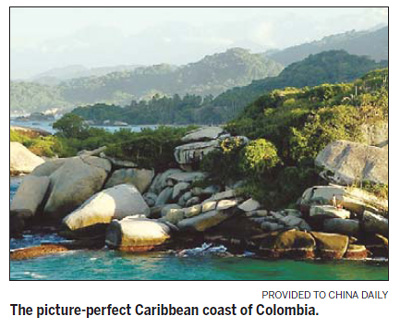Life and Leisure
Once plagued by crime, now a town of style and romance
(China Daily)
Updated: 2010-09-24 08:09
 |
Large Medium Small |

It's not called the Parque de Los Novios - Park of the Newlyweds - for nothing. Young couples lock arms as they stroll past rows of freshly planted flowers. A Frank Sinatra love ballad sung in Spanish echoes from a bar. Aside from a few mustachioed, sombrero-clad men playing a board game, it seems as if everyone is on a romantic sabbatical.
Yet this square in the center of Santa Marta, a port city along the Caribbean coast of Colombia, was not always a streetlamp-lighted refuge of romance. Just a few years ago, the park was a tumbledown area trafficked mostly by prostitutes and petty criminals.
Wedged between the sea and the snow-capped Sierra Nevada de Santa Marta peaks, the city may be Colombia's oldest, but it has always been seen as the grittier and more industrial counterpart to nearby Cartagena.
"Until five years ago nobody would come here because of the guerrillas," says Michael McMurdo, a New York City-trained chef who recently opened a Mexican restaurant, Agave Azul, in Santa Marta.
"While there is still some sketchy stuff going on, I like it here because it still feels real and Colombian."
The town's transformation began with a government crackdown on illegal drug and paramilitary activity in the region. The efforts have paid off: Tourism has now replaced crime as Santa Marta's claim to fame.
The number of international visitors to Colombia in 2009 spiked 17 percent from the previous year, helped along by the emergence of former rebel hideouts like Santa Marta as new tourist destinations.
The Colombian government has also spent plenty of money to revamp the city's parks and convert streets into pedestrian zones. But what the government started, a wave of polyglot businesspeople like McMurdo has continued, helping to resuscitate Santa Marta's colonial center.
Shops selling religious iconography and smoky billiards halls are giving way to Tuscan-style hotels and tapas spots that double as jazz bars. Even the once-grimy boardwalk now feels more like a smaller-scale version of Rio de Janeiro's Ipanema.
Perhaps the perfect monument to this city's rebirth is a gleaming new marina that anchors the waterfront; huge and visually spectacular, it wouldn't look out of place in Dubai. The terminal can handle more than 250 yachts and super yachts.
On a recent late-summer evening, a stylish crowd of Colombians and expatriates mingled at Ben&Josep's, a new steakhouse run by a Spanish-Belgian duo, down the boardwalk from the marina. The steakhouse is just one of the additions to the city's seaside area, which has been spiffed up in recent years with greenery and dotted with statues of shapely, warrior-like indigenous women.
Away from the beach, the city abounds with Spanish colonial charm. Among the streets off Parque Simon Bolivar, wanderers will find a whitewashed cathedral that claims to be South America's oldest.
To stay cool, visitors can grab some coconut water, sold just outside the cathedral, or rest in the shade of the patio of the nearby Juan Valdez Cafe, Colombia's go-to coffee chain.
Of course there's more to Santa Marta's culinary offerings than coffee. The jumble of fare here is as multicultural as the city's mix of ethnicities and musical influences; African, Caribbean, European and Latin flavors vie for space on menus. At Gourmet Plaza Bistro, where the decor includes old TVs and typewriters, diners can sample home-cooked pechuga ricotta, a Colombian-Mediterranean hybrid, as well as tasty crepes. For gourmet ceviche, head to Donde Chucho, an upscale restaurant on a corner of Parque de Los Novios.
Santa Marta also benefits from the bounty of virgin tropical forests close to the city center. For a relaxing getaway, grab a taxi or mini-bus to Taganga, a laid-back oceanside hamlet ringed by a horseshoe-shaped canopy of lush green hills. The strip of sand in town feels more like a dirt driveway than a tropical beach. But the sunsets are breathtaking, especially from the rooftop bar of the Mirador de Taganga Hotel along the town's southern fringe. The Caribbean waters there are also perfect for scuba diving.
On the other side of Santa Marta lies El Rodadero, a Cancun-like strip of stylish restaurants, open-air markets and high-rise hotels along beaches that fill with well-to-do locals on weekends.
Though Santa Marta is no longer plagued by the kidnappings and killings that kept tourists away for decades, petty crime remains a problem. But the city has made great strides toward putting its bloody, drug-riddled past behind it.
Evan Dore, a shaggy-haired native of San Francisco, remembers driving through this part of Colombia four years ago with his brother, Ryan, in a 1981 VW bus. The pair left unimpressed. But two years later they decided to return and restore an 85-year-old mansion, now La Brisa Loca, a hostel and bar aimed at backpackers. They were attracted by Santa Marta's authenticity, which it has maintained despite the recent development.
"The city is full of people going about their daily lives, going to work or selling things on the street with almost no interest in a foreigner walking around," Dore says. "Santa Marta is the real South America I was searching for."
The New York Times